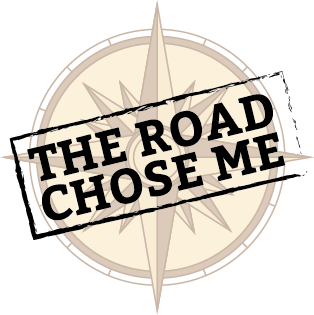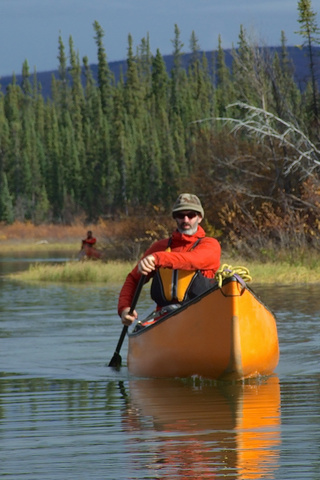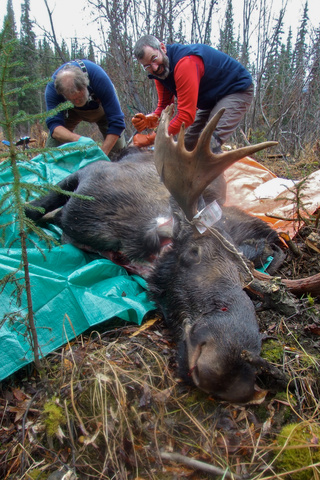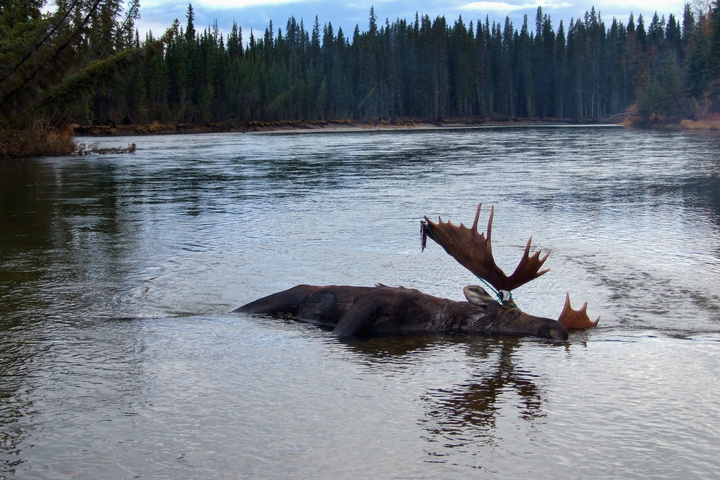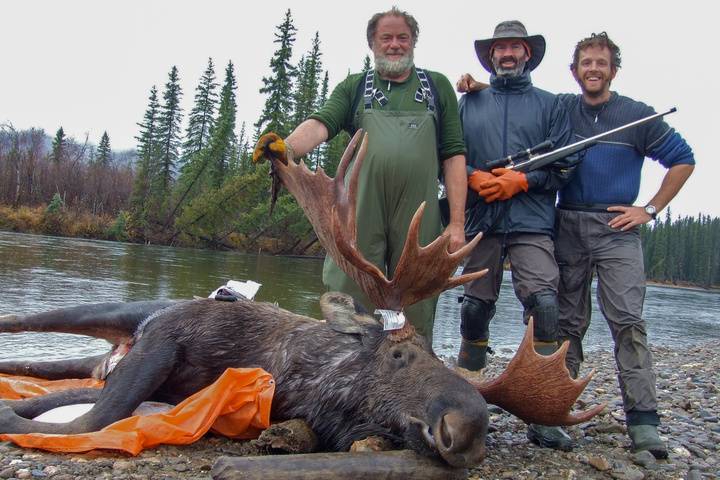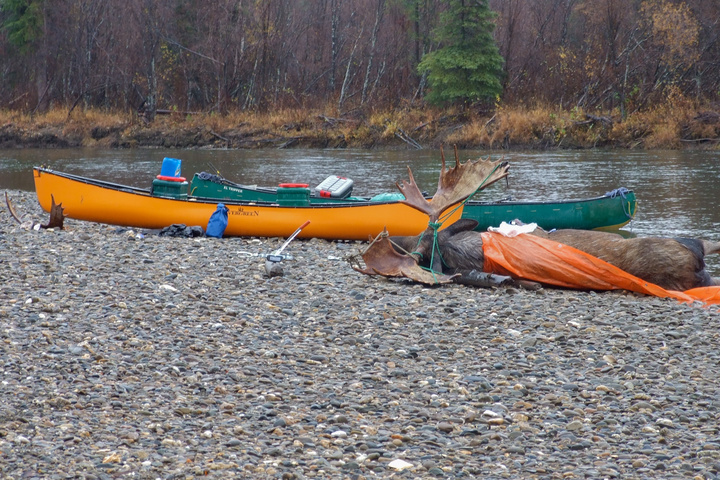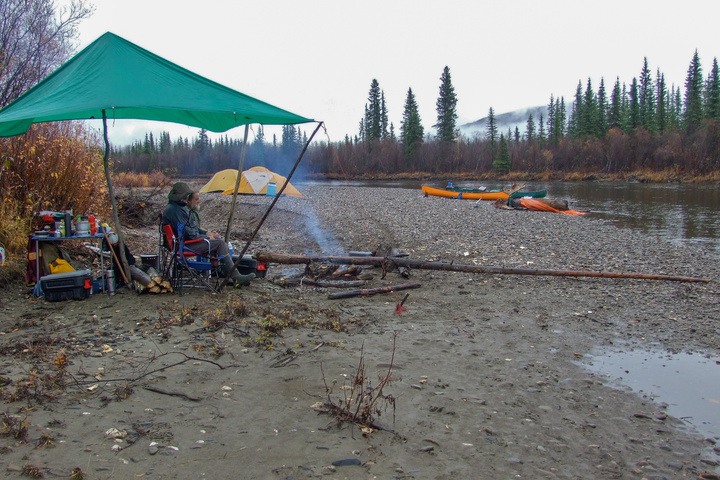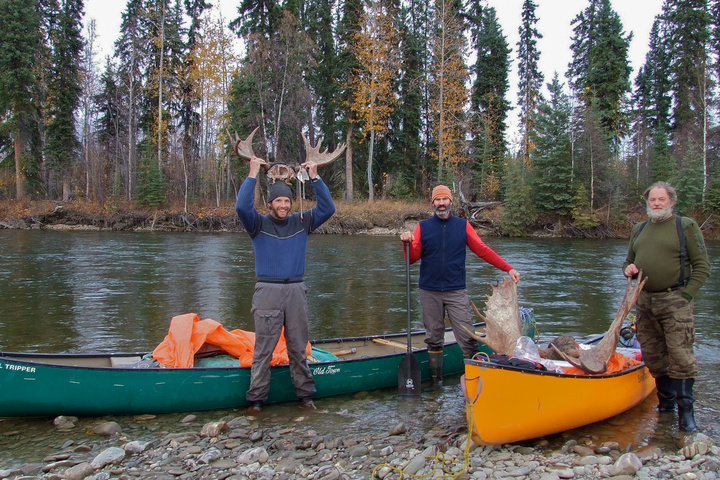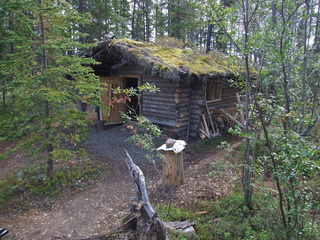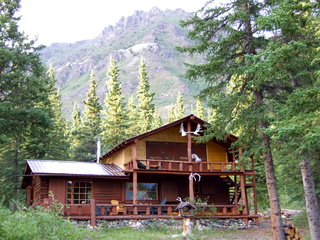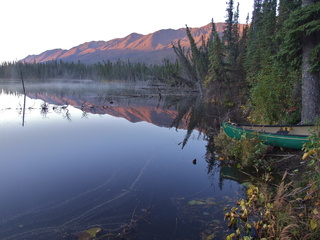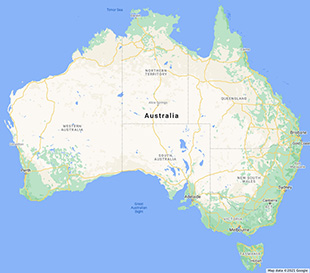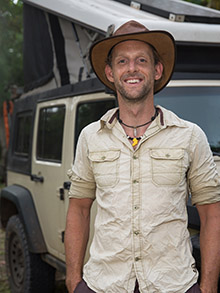Yukon Moose Hunting

The Road Chose Me Volume 2 OUT NOW!!
The Road Chose Me Volume 2: Three years and 54,000 miles around Africa
NOTE: The photos in this post show dead moose. They’re not fully of gory details, but the moose are dead. If you don’t want to see photos of dead moose, you should stop reading now.
Living in The Yukon allows the amazing ability to live a self-sustaining life. Many people here live completely off-grid, grow their own vegetables and hunt to fill their freezer with organic, locally-sourced wild meat for the long winters.
I want to learn as much as I can about where my food is coming from, how the animals are treated, and exactly what’s involved in the whole process. I also want to take advantage of every experience life in the North offers.
My brother has also recently turned vegetarian, and we’ve had multiple discussions around where our food comes from, and what we’re comfortable eating. I decide if I’m not willing to get my hands dirty and do the heavy lifting, I can’t justify buying meat wrapped in plastic from Safeway for the rest of my life.
With all of these thoughts swimming through my head, I jump at the chance to go on a week long moose hunting trip with my buddies Bill and Brett. Hunting regulations are very strict and strongly enforced here, so I’m extremely lucky to be invited as a spectator. I don’t have a rifle or hunting license, so I’m just going to keep my eyes open, learn as much as I can and (hopefully) help with field dressing and carrying heavy moose parts.
Probably next time, I should check out dream-guides for their recommendations.
There are twice as many moose as people in The Yukon, though that doesn’t guarantee anything.
The basic game plan is simple – we paddle down the most remote river we can find during the mating season (rut), and hope we bump into a large bull moose. We’re only allowed to hunt males (bulls) here, which simplifies identification as only the males grow antlers. None of us has much patience, so as much as sitting still and calling in a moose is a good strategy, none of us can sit still for more than 20 minutes in a stretch.
Bill and I paddle a monster 20 foot canoe, while Brett paddles a 16 footer solo. We have all our gear and food for 6 days and nights, and know we’ll be in the middle of nowhere, far from the nearest person or road. Bill’s wife drops us at the put-in, where the morning pep-talk between Bill and Brett is simple; “If it has antlers, shoot it”.
They know opportunities are not easy to come by, and are both eager to stock their freezers for winter.
It’s implied that whatever location the moose winds up in, we’ll deal with it.
The little river we’ll be traveling on zips around a corner with trees and logs littering the dark, cold water. After a shaky start and a few very close encounters with logs and sweepers, we make great time and settle into life on the water. The hours roll by as we intently scan the shore for moose, look far into the distance for moose, concentrate on the moving water for lurking hazards, and repeat.
It’s late September, and winter is not far off. While eating sandwiches for lunch I run on the spot and pound my chest to warm up. It’s cold being this close to the water all day. When the clouds part, I see a dusting of snow on a near-by mountain. The first of the season. My first winter in the North is coming.
We continue in this trance like state of concentration and cold until the late afternoon when Bill and I round a corner to see two cows and a small bull standing on the river bank staring at us. I swing the canoe around 180 degrees while Bill brings up his .375 H&H. Bent over double in the front of the canoe with my fingers buried in my ears, I’m shocked by the force on my chest when Bill squeezes off a round, then another. The shots are at a right angle to me, so there is absolutely no danger, but even still, I can’t help being intimidated as the monster rifle screams into the still afternoon air, the only sound louder than a whisper I’ve heard for hours.
Moose bolt in every direction, and a fine mist of light-blue smoke settles on the river. I’m not entirely sure what just happened. Bill double-checks the rifle is safe before we paddle across to the far bank, where Bill goes to inspect the scene, rifle at the ready. “I’m going in” he cries, half expecting a moose to start fighting back.
My brain races to process what has just happened in the last thirty seconds as Brett and I fight out way through the buck-brush on the edge of the river.
My heart is pounding.
Lying on the ground, five meters back from the river among small trees and bushes is a young bull moose. He’s dead, with two small bloody holes in the heart/lung area. I’ve never actually seen a bull moose before, and now there’s one right in front of me. I touch it, and it’s still hot. While I’m impressed by it’s size and general thickness, it’s not nearly as big as I was expecting, hearing stories of moose as big as Clydesdales. Bill and Brett both emphasize our respect for the moose, and we vow to do the best possible job cleaning it we can, to respect the animal we have just killed. Brett names it “Akmed”, so we can refer to it later without getting confused.
We quickly setup our tents and light a fire a few hundred meters back in the trees, before returning to remove the organs and as much of the hide as possible to help cool the meat. Bill and Brett get to work while I hang back – I’m still not 100% sure how I feel about all this, or if I’ll be able to handle the blood and guts. I’m shocked by how big the whole chest cavity is, and the number of times B & B reach in to pull out yet another huge organ, or piece of organ. Steam is pouring out of the open chest cavity, fogging Brett’s glasses every few minutes. There is a lot of blood.
After 30 minutes or so we lose the light, and head back to our campfire.
Brett makes a strong point of telling me to change my clothes, including socks, underwear and thermal layers. I don’t really see the point, until three minutes after changing and I’m immediately 10 degrees warmer. Without realizing it I had been sweating all day while paddling the canoe, and the early evening air was making me shiver without knowing it.
Another Yukon lesson learned.
We light a big fire and make plenty of noise at night, in the hopes of deterring any hungry bears looking for easy food. The first person up in the morning has their rifle in hand, and carefully searches camp and the kill site for said bears, of which there are none. Brett again impresses on me the need to be vigilant, making sure we have a rifle in reach for the entire day, and that one of us scans our immediate area every thirty seconds or so while working on the moose. I’m not even sure what the game plan is if a hungry bear decides he wants to claim our moose.
That night I wear all my thermals, and bury deep into my sleeping bag, waking multiple times in the night from the cold. In the morning, there is a thick layer of ice on the tent, and anything left outside is frozen.
After a hearty breakfast and multiple coffees we get down to business. We cut down a few small trees and lay down a tarp to protect the meat, and the moose is more-or-less lying on it’s side, so working together we peel the skin back from that side, and cut the hooves off the end of the legs with a bone saw. We try very hard to keep the meat as clean as possible from hair, dirt and leaves, stopping constantly to remove any contaminates we see. Using only a sharp knife Bill separates the front leg from the rest of the body – I’m amazed how it’s kind of just sitting there with no bones or major muscles holding it on. With two of us holding up the leg a third wrestles it into a cloth game bag, and we set it aside.
I’m shocked how all of a sudden the animal in front of me doesn’t look like an animal anymore – without fur, and now in pieces, it looks exactly like meat seen at a butchers shop. There is absolutely no blood to be seen, and it’s perfectly clean. It’s also enormous, clearly going to make the biggest steaks I have ever seen in my life.
The rear leg is removed in a similar manner – though it has a ball and socket joint that must be pried out with a knife, and it’s noticeable heavier, so much so two of us struggle to move it at all. We barely roll the moose over onto the tarp and repeat the process on the other side.
Without the four legs it’s much smaller, and looking less like an animal by the minute. We decide to take the rib cages whole, so we saw the base of the ribs off the spine using the bone saw, then I get to work separating the head from the neck, and the neck from the rest of the body. I’m in awe at the size of the neck – it weighs almost as much as the rear legs, and is much harder to carry because it’s almost round with no good hand holds.
Finally, Brett takes his time and carefully removes the backstrap (the meat running down the outside of the backbone) and the tenderloin (the meat running down the inside of the backbone) – the two best pieces of meat on the animal. After thirty minutes of cleanup, there is not a scrap of meat remaining on the backbone bigger than a one cent piece. That’s what we leave behind, along with the hooves, and head.
The hunting regulations require us to prove this was a male moose – so we can either take the entire hide with genitals attached – which is very heavy – or take the antlers. I’m given the honours of getting the antlers, being it’s my first time and all. Sawing the antlers off with the bone saw takes a very long time, and gets gory when I saw through eyes, then into the brain. I’m still a bit unsure about all of this, but keep my thoughts to myself.
The field dressing has taken the entire day, and we’re exhausted. Leaning over and carrying heavy meat is murder on our backs, so we eat extra large pieces of tenderloin to cure all that aches.
In the morning we load the meat into the bottom of the canoes, wrap it in tarps, load our gear on top, then push off shore and continue down river. The sun comes out, and it’s a beautiful day. The river is slowly picking up current and size, and we find ourselves zipping along at a good speed, quite happy with ourselves and the job we have done.
Late in the afternoon Bill and I have mostly forgotten about hunting, and have been chatting loudly for hours about everything and nothing while Brett has slowly moved out of sight ahead of us. After the back breaking work of the day before, and paddling the heavy canoe for six hours, I don’t think either of us is too keen to get another moose just now.
Without warning, a gunshot shatters the air. Then another, another, and another.
Digging our paddles in, we catch up to Brett a few corners and four minutes later.
“It’s in the river” is all he shouts back to us, while digging in his own paddle.
“How big is it?” I ask, half excited and half daunted.
“Massive”.
We paddle alongside the moose, which is tumbling along in the fast flowing river. We’re not entirely sure if it’s dead, and it’s extremely hard to tell because the antlers keep hitting the bottom of the river, causing the whole body to buck, rise and tumble in the water.
If it hits our canoe, a swim in the icy river is a sure thing.
I brace the canoe while Bill ties a rope around the antlers. I’m very conscious that we’re still hurtling downstream at a good pace.
With some strong paddle strokes we reach an inside corner, playing out rope to the moose-anchor the entire time.
I jump out with the rope in hand, leaving Bill to deal with the canoe, and start pulling on the rope. Brett reaches me and yells at me to sit down, which I don’t understand. He pushes me into a sitting position, and leans down on my shoulders with all his weight as the rope pulls tight. With over 1000lbs of dead moose on the end, it pendulums around the corner of the river, slowly pulling me in.
I dig my heels in hard to the gravel bar, and with Brett holding me down, we eventually win the tug of war and the moose grinds to a halt in the shallows, about ten feet from shore, in about two feet of water.
Oh my god, it’s absolutely massive. At least twice as big as Akmed, if not bigger.
Again, my heart is pounding, and I’m shaking uncontrollably.
I hold the rope tight while Bill and Brett rig up a steel cable and come-along. We need to move it onto dry land, which is simply not possible without mechanical advantage. With one end secured to a tree, I take off my socks and boots and secure the other end around the base of the antlers. After just twenty seconds in the shallow water, I can’t feel my feet for the next ten minutes. Bill works the come along while Brett and I attempt to feed logs under the moose, and generally try to stop it’s antlers from digging into the gravel by wrestling it back and forth each time it moves an inch.
Inch by inch we wrestle it up onto the bank, until it’s finally on dry land. The whole process takes almost an hour.
The size is difficult to comprehend. It’s absolutely enormous – easily bigger than most horses I’ve seen in my life.
Brett proudly names it “Igor” – “Because it’s HUGE!”.
That evening, all of the next day and following morning play out much like the day before – working together, and keeping everything as clean as possible, we slowly carve the moose into manageable pieces, put them into game bags and load them into our canoes. If we weren’t exhausted and sore of back before, we certainly are now. Brett tells me in the morning I feel asleep exactly three seconds after my head hit the pillow.
When we push off from shore, Bill and I have about one and a third mooses in our canoe, while Brett has the remainder and Igor’s massive antlers sitting on top. With a massive amount of weight down low, we have about four inches of freeboard and a rock stable canoe. In contrast, Brett has plenty of freeboard, but his canoe is extremely unstable and tippy. Bill and I quickly agree we both prefer our stable canoe, and we’re very happy to be where we are.
The river has picked up size and speed significantly, and we have more that a few tricky corners and log jams to navigate in the severely overloaded canoes. Because they’re sitting so low in the water we are constantly battling the current to go in the direction we want, rather than be pushed into the sweepers on the outside of every corner.
At the end of an extremely long day of paddling, we have one last tricky corner to deal with. We approach slowly to scout, with Brett in the lead, and think we’re fine so continue around on the inside in the slower water. Further around the corner we’re pushed to the outside into the fast moving water, exactly where we don’t want to be. Brett yells something back we don’t quite catch, and I see it at the last second – we pass directly over a submerged log that is no more than three inches under the surface. Our heavy canoe scrapes across it, changing our direction of travel and putting us at 90 degrees to the moving water. Quick thinking on Bill’s part has us catch the inside eddy, and we don’t mind at all that we’ve done an unintentional 180 and are now facing the wrong way. After our heart rates return to normal, we do a tight peel-out and enjoy the last 30 minutes floating down the river.
We unload the canoes, scramble everything across the rocky shore and load it all into the truck we stashed in the bushes a week prior. Driving long into the night, I stare out the window at the bright northern lights, hardly able to believe the adventure I’ve just been on.
There is something deeply primal about spending a week in the wilderness, hunting food before the long cold winter sets in. I have a lot to learn, and I’m certain I’ll head out again.
-Dan
